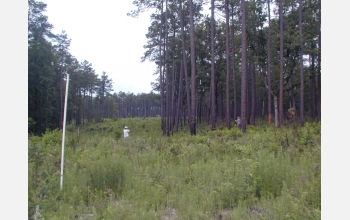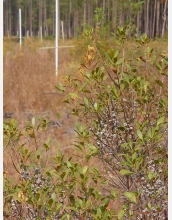All Images
News Release 05-110
Landscape Corridors Provide Pathway for Seed Dispersal
Birds help habitats maintain diversity
This material is available primarily for archival purposes. Telephone numbers or other contact information may be out of date; please see current contact information at media contacts.

Biologists placed wax myrtle branches with ripe berries in central clearings, marking the berries with a harmless florescent dye so that they could track the berries' whereabouts. Using the florescent markers, they were able to identify seeds that came from plants in the central patches. Seeds were more likely to be found in the central clearings of connected patches than in the central clearings of isolated patches.
Credit: Nicole Rager Fuller, National Science Foundation

Researchers record the movements of a bluebird along the edge of a forest in South Carolina. By recording how long bluebirds perched, how far they flew between perches, and the direction of each flight, they were able to construct a model to predict over large distances where the birds would go and where they would disperse seeds.
Credit: Doug Levey, University of Florida.
Download the high-resolution JPG version of the image. (494 KB)
Use your mouse to right-click (Mac users may need to Ctrl-click) the link above and choose the option that will save the file or target to your computer.

The grayish fruits of wax myrtle (foreground) are a favorite food for many wild birds in the eastern United States. Bluebirds ate them in the winter at the authors' study site in South Carolina and dispersed their seeds into open habitats, where wax myrtle thrives.
Credit: Doug Levey, University of Florida.
Download the high-resolution JPG version of the image. (352 KB)
Use your mouse to right-click (Mac users may need to Ctrl-click) the link above and choose the option that will save the file or target to your computer.


